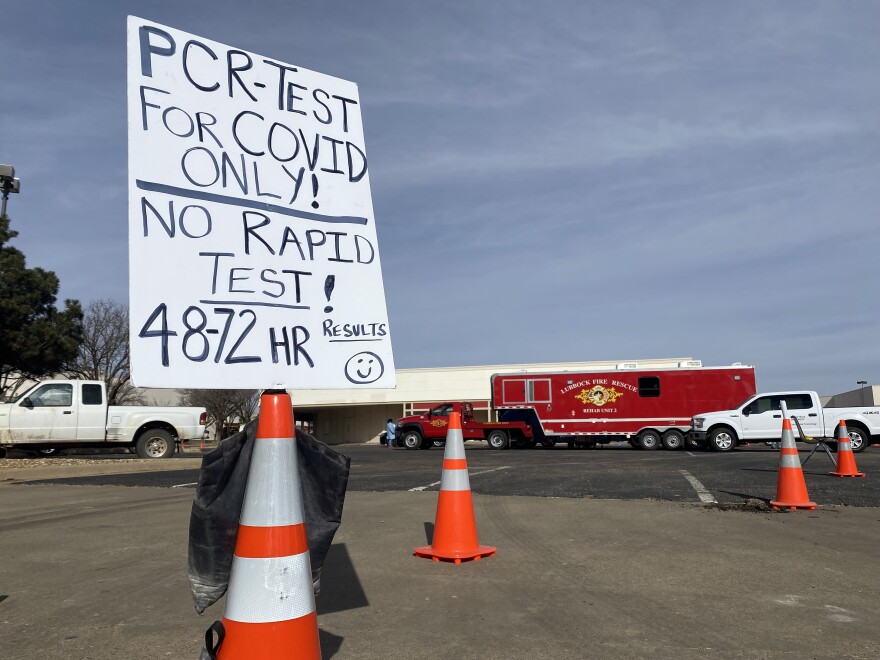Tyler Wood got out of quarantine on Monday. The clinical pharmacy supervisor for Covenant Health described the symptoms he experienced.
“I had some sniffles…I didn't think it was COVID. I am fully vaccinated, had the booster,” he said. “And then lo and behold, it was COVID.”
Wood returned to work the same day Lubbock’s COVID new case count hit an all-time high – 813 new infections. Prior to that, the highest number of cases confirmed in a day was back in November 2020, with 670.
“This week is when we saw the biggest eye opening, you know, here we go again, moment,” Wood said.
Cities and counties across Texas are in the same boat. This week San Antonio Metropolitan Health reported one of the highest single day increases ever seen for Bexar County.
In Lubbock, Wood said it’s taking a toll on the hospital.
“We've got less staff,” he said, recalling that travel and agency nurses were brought in to alleviate the strain during previous waves, but then they were sent home. “Now we're having to bring them back because we don't have enough nurses to staff our beds.”
That’s a problem in hospitals all over the state.
Bill McKeon, chief executive officer of Texas Medical Center in Houston, said normally the number of staff out would range from tens to a couple hundreds. Now, they’re seeing several thousand.
“It is the largest amount of employees we've ever seen out,” McKeon said.
It’s happening as more people are showing up at the hospital. Last week, Texas Medical Center’s average daily COVID-19 hospitalizations nearly doubled from 201 people a day to 401. On Tuesday, officials in Austin said hospital admissions increased 135%. And Dallas’s Parkland hospital just opened a third ward for COVID patients.
“It's been the largest surge ever,” McKeon said. “And we've been at this now, almost two years.”
So far, omicron seems to be less severe than previous COVID strains. McKeon explained that it’s hitting people differently.
Unlike the previous variants, he said, omicron attacks the upper airways– the throat, nose and mouth. Meanwhile, the lower respiratory system seems to be more resistant to omicron than it was for delta.
“So we're seeing far fewer patients, for example, having pneumonia, needing to be put on respirators,” McKeon said.
Which translates into fewer patients filling the intensive care units for long periods of time. There’s a caveat, however.
“The difficult thing about omicron is because it's in your upper airways system, it's much more transmissible.”
More transmission means omicron-related staffing shortages in hospitals – and beyond – could be a problem for weeks.
While hospital stays may be shortened with the newest variant, City of Lubbock Public Health Director Katherine Wells said any spike is alarming.
“There's still a concern that there's gonna be a group of people that are still going to need medical care,” she said, considering figures recently seen in her city. “If you end up with 800 cases a day, and you know, 5% of those people need medical care, you're going to overwhelm the medical resources very quickly.”
In Lubbock, only two cases of the variant have officially been confirmed. But based on state and national data, Wells is operating under the assumption that the majority of what Lubbock is dealing with is omicron.
Right now, omicron is the dominant COVID-19 strain in the country. “I think there's different places in Texas that are feeling the strain differently right now,” said Jennifer Shuford, the state’s chief epidemiologist.
“There are places across Texas where there’s still leftover COVID patients from the delta wave,” she said, pointing to the El Paso and Amarillo areas. “They haven't fully recovered from the last surge.”
Shuford also pointed out that the state is dealing with shifting and dwindling treatment options – like the monoclonal antibody therapy treatment, sotrovimab, the only one shown to be effective against omicron.
“Unfortunately, the manufacturer hasn't had enough sotrovimab to provide the country with enough supply to meet demand,” Shuford said.
So, every state is grappling with what Shuford described as meager supplies while omicron cases increase across the board.
In order to not exacerbate the situation, Shuford said Texans should still take omicron seriously. While it seems less severe, she cautions that the research that shows that is still so new and incomplete.
Shuford and others are hopeful that like it did in South Africa, this omicron wave will come down as quickly as it spiked. But she said that comparing the situation in the U.S. to that of South Africa is a little bit like comparing apples to oranges.
Rachel Osier Lindley with KERA, Joey Palacios from Texas Public Radio and Matt Harab with Houston Public Media contributed to this story.
Have a news tip? Email Kaysie Ellingson at kaysie.ellingson@ttu.edu. Follow her reporting on Twitter @KaysieEllingson.
If you found the reporting above valuable, please consider making a donation to support local nonprofit journalism. Thanks for donating today.



